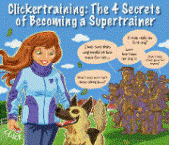Good Dog Training Advice
Get Fast & Simple Dog Training Tips to
Turn a Difficult Dog Into an Obedient Pet!
How to Stop Your Dog from Chasing Cars and Cats
It's a funny thing. Many of the behaviours our dogs have as puppies are much cuter when they have no power to follow through. Chewing on our shoes is cute until they get older and tear them up. The same is true for chasing cats or cars. They cannot reach them, so it's cute. But, by laughing and taking pictures of your dog chasing cats or cars as a puppy, and not stopping the behaviour, you're only permitting it to persist and putting your dog at greater risk as they age. The Root of Chasing Dogs chase for a number of reasons. Part of them has an innate hunting instinct that tells them to chase prey. A cat might trigger that instinct, and even if the dog would never hurt the cat, he will continue chasing it as long as the "prey" runs away. The same is true for cars. Because they are loud and constantly driving by, coming in and out of your dog's senses rapidly, they will chase them. Their barking chases off the car, right? The simple fact that a car is mobile only drives this behaviour into them deeper, making it harder to adjust. Solving the Chasing Problem No matter how ingrained it may be or how cute it once was, there are serious risks when your dog likes to chase either cats or cars. The danger in chasing cars should be fairly evident. The dog forgets the value of staying to the sidewalks and can quickly put itself in danger. The same can be said of cats, however. A cat being chased may decide to stand up to a dog, causing a great deal of damage to him if the two are not careful. Additionally, a dog and cat can tear a swath of destruction across your house when you're not home - especially with the cat's nimbleness in play. So, it's important to stop your dog from chasing cats and cars as soon as possible. Here are some tips: * Controlled Training - To start with, you need to train your dog, in the house, in a controlled setting to be able to follow commands while distractions are present. Dogs need to concentrate to follow your cues, which requires quiet and familiar settings. Teach your dog to sit, heel on a leash, and pay attention to you and you only while in the house. Then, upgrade your training to walking on a leash outside. Only when your dog can follow commands both inside and on a leash should they ever be unleashed. * How to Practice - It's important to practice in a setting where your dog cannot get hurt. Introducing your dog to a cat in your house can be a good way of testing their ability to stay calm and submissive. Make sure you do it in a closed room, with minimal distractions. This is good dog training advice that you should take note. Keep your dog on a leash as well so they do not get too carried away. Leave space for your cat to escape if necessary and then let the two meet. You can do the same with a jogger or bicycle outside, having them run or ride by your dog while you control him on a leash to see how he responds. * Cars and Safe Settings - Cars are the most dangerous issue and should be addressed early in life. Do this by making sure your dog never has a chance to chase them. Teach him to sit at curbs, to heel and only to sniff or inspect with your permission. Effective training of your dog will start and end with you knowing how to trigger the right behaviours and tamp down the wrong ones. The biggest example of this you'll ever see is in regards to chasing. Dogs love to chase - control that and you know he's paying attention. And just a final reminder before I sign off for today... to put a stop to your dog's disobedient behavior once and for good (including barking, digging, chasing cars and cats, aggressions, jumping and more), I highly recommend that you check out: | |
|


Discover the Secrets to Training Your Dog Or Puppy. Huge BONUSES for a limited time only!
Click here now...
|
http://GoodDogTrainingAdvice.com





